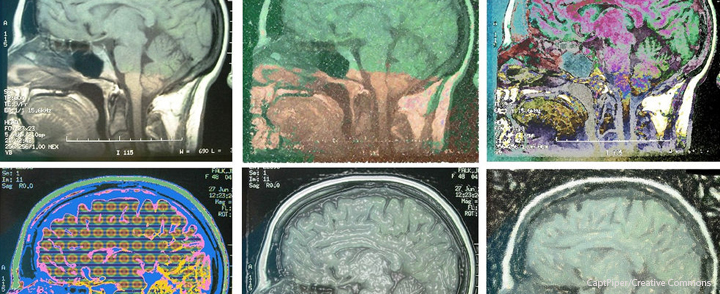By Janis Siegel, Jewish Sound Columnist
As part of his U. S. brain initiative in 2014, President Obama visited Israel and learned about groundbreaking brain research developed by Ben-Gurion University of the Negev researchers. This is part one of a two-part look at some of those technologies.
He’s Ben-Gurion University of the Negev’s resident warrior against autism.
His lab’s credo, the Dinstein Computational Neuroimaging Lab reads, “We want to transform the definition of autism from one that is behavioral to one that is biological.”
Ilan Dinstein, 38, a senior lecturer in the department of psychology and the Zlotowski Center for Neuroscience, along with his research team, are singly focused on detecting autism in children well before the current age of 2 or 3 years old by studying how each part of the autistic brain performs differently.
“My passion is understanding the brain,” said Dinstein in a BGU interview. “What we want to do in my lab is to develop techniques to identify autism at the age of 1 or 2 using biology. We want to look at the brains of children and be able to identify those who will later develop autism. The earlier you intervene, the better the outcome.”
While many researchers concentrate on surveying the whole brain, looking for areas that do not fire the way a normal brain would, Dinstein is exploring each section of the brain while assessing its ability to function properly.
“Of all the parts of the body, the brain is probably the least understood organ,” Dinstein said. “Even though it weighs only three kilograms, it’s what makes you yourself. It’s all located in this small box that we know very little about.”
Globally, according to the World Health Organization, an autism spectrum diagnosis occurs in roughly one in every 160 children and in one out of 100 in the U.S. An autism diagnosis covers a spectrum of conditions that include Asperger syndrome and childhood disintegrative disorder.
Children with autism have problems interacting and communicating socially. They exhibit many physical “tells” such as chronic repetitive behaviors, pronounced clumsiness, and an overly sensitive reaction to sound and sensory experiences.
Using several imaging tools, Dinstein’s team takes functional and Magnetic Resonance Imaging — fMRI and MRI — Diffusion Tensor Imaging, or DTI, and Electroencephalography or EEG to explore the brain’s ability to function, but that is only half of his process.
By taking an anatomical MRI, he then compares the volume, thickness, and folding of the several frontal lobe areas of the brain, comparing it to brains that do not exhibit the autistic syndrome.
Next, he maps out the gray and white matter of a normal brain to use as a roadmap, superimposing it over an image of the same brain matter from an autistic child to note differences.
Researchers can see how the sensory systems behave and whether an autistic brain’s connections are similar to the same system of a healthy brain.
In 2012, doctors believed that autism was a malfunction of the brain’s ability to generally process neural signals. In autism patients, those connections appeared to be “unreliable” and unclear.
Investigators concluded that the spectrum of behavioral effects were originating from one part of the brain and producing the various autistic symptoms throughout the whole brain.
That year, Dinstein and his team tested several parts of the brain in autistic patients to further identify which parts of the brain affected the autistic person’s ability to react and respond to everyday communication. The results, titled “The Unreliable Evoked Responses in Autism,” were published in the September issue of the journal NEURON. The study included 28 subjects — 14 with autism and 14 subjects who did not. The autistic group had a median age of 26.5 and the non-autistic group’s median age range was 26 years old.
“Each participant completed three event-related fMRI experiments,” wrote Dinstein, “which enabled us to measure stimulus-evoked responses independently in the visual, auditory, and somatosensory systems.”
Researchers combined meticulous brain signal processing techniques with complicated computational methods that used classification and clustering algorithms.
Dinstein posited that a complete identification and classification of the remaining basic neural processing characteristics, like plasticity and selectivity, are essential to the understanding of autism. This approach could also be helpful in accurately connecting neurophysiological abnormalities with potential genetic or molecular functioning that may lead to the development of autistic symptoms.
“The first goal is to better understand what are the biological mechanisms that underlie the emergence of the strange and unique cognitive and social behaviors that are exhibited by individuals with autism” said Dinstein. “The second goal is to identify objective biological measures that will enable early and accurate clinical diagnosis of autism, which would be able to replace or at least complement the subjective behavioral measures that are currently used for diagnosis.”
Longtime Jewish Sound correspondent and freelance journalist Janis Siegel has covered international health research for SELF magazine and campaigns for Fred Hutchinson Cancer Research Center.

[…] (Thanks to Nevet – http://www.broaderview.org) Ilan Dinstein, from Israel’s Ben-Gurion University, is using MRIs, DTIs and EEGs to transform the definition of autism from one that is behavioral to one that is biological. http://jewishinseattle.us/gray-and-white-matters-mapping-autism-in-the-brain/ […]
[…] (Thanks to Nevet – http://www.broaderview.org) Ilan Dinstein, from Israel’s Ben-Gurion University, is using MRIs, DTIs and EEGs to transform the definition of autism from one that is behavioral to one that is biological. http://jewishinseattle.us/gray-and-white-matters-mapping-autism-in-the-brain/ […]